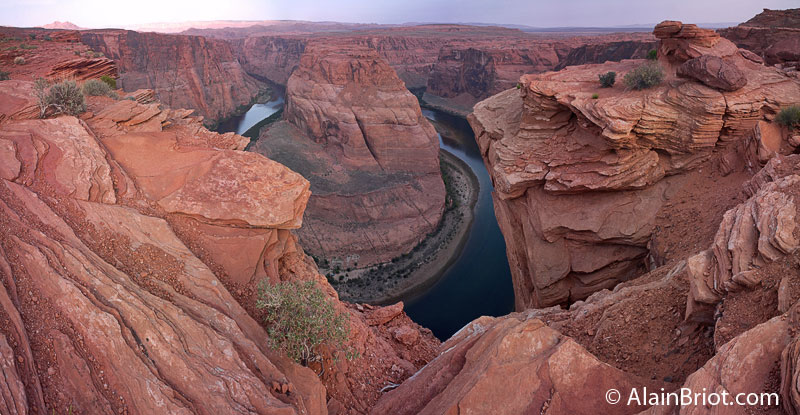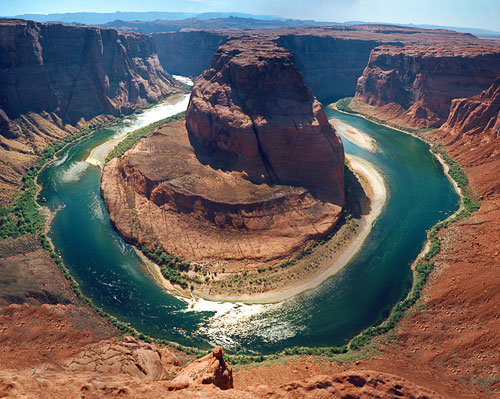Alain Briot
pro member
Here is a "reprint" of an essay that I originally published on my site on May 5th, 2008.
Horseshoe Bend 2008
Phase One P45 Collage
by Alain Briot
Horseshoe Bend 2008
Phase One P45 Collage
by Alain Briot
Introduction
In March 2008 I purchased a Phase One 45 digital back. This purchase was motivated in part by the desire to have large digital files to create fine art prints, and by the need to have equally large files for a commercial assignment that I worked on in Southern France in April.
Phase One's P45 comes in a variety of mounts designed to fit just about any medium format camera make or model. Since I had a complete V Hasselblad system (the traditional Hasselblads) I decided to get the V Hasselblad version of the P45. All the versions of the P45 are similar except for the mount which is specific to each camera manufacturer.
I will have a detailed report on my experiences working with the P45 soon so I won't go over the technical aspects of the back in this essay. Instead, here I want to focus on one particular use for this back and that is the creation of multi-image collages.

Horseshoe Bend 2008
Why so big?
One could legitimately ask this question. The P45 generates 39 mp files, which equal an 18x24 print at 300 dpi without any upresing. With a simple 2x upres, which is considered to be a "normal" upres, the print size jumps to 40x50.
However, what I am talking about here are not single captures. What I am talking about are collages done from several P45 captures. For example, the image above Horseshoe Bend 2008, consists of 5 P45 captures stitched together using Photoshop CS3 Photomerge.
It's the composition!
Why do it? For the composition that is. The 5 photographs used for the collage above were done with a 38mm Zeiss Biogon. This is a wide lens, but I wanted to show more than the field of view it delivers. I wanted to show a panoramic view of the Horseshoe Bend in which I could include a lot of the foreground. The only way to do this was by taking several photographs and merging them.
Here comes Photomerge
If you haven't tried the CS3 version of Photomerge in CS3 (not the CS2 Version), and if you like collages, you ought to yourself to do so as soon as you can. The quality of the collages is awesome, and the ease of use is superb. I usually select the "auto" option, and in the few instances were it fails to deliver a good image, I select the "reposition only" option. Between the two I nearly always get a perfect result. Seamless images that look as if they were shot with a single shot although the look of the image tells you that such was not the case.
I use to have to use PT GUI and other specialized stitching software to get this type of results. Not anymore. In fact, I don't even use a panoramic setup. I simply place my camera on my ballhead, as I would for a normal shot, then pan from right to left. It helps if you level the tripod, but if you don't and you are careful to keep the horizon level, you will do just fine. I am not a software engineer, and I don't know how Photomerge works or what code lies behind the results I get, but all I can say is that whoever wrote the code and designed this software ought to get an award. It's that good.
It picks up where I left off. Somehow, it knows in which order the photographs go, and somehow it knows how to blend them together so that there is no evidence left that these are stitched single shots and not a regular photograph.
So the question remains, why not use a smaller format image file, such as Canon captures for example? Well, for one, because I can. After all, why not use the best equipment available? For two, because I love the image quality of the Phase One P45. I will have more on this later in my upcoming experience report, but for now let me just say that there is a quality of color and contrast that I have not experienced with other digital captures, regardless of size or brand. I haven't tested all the digital cameras or backs out there (I much prefer taking photographs to testing equipment) so my opinion is somewhat biased, but the fact remains that the image quality is the reason behind my choice of equipment when it comes to capturing images for stitching.
10 years apart
Before I close another point is worth making, and that is the reason why I want to create stitched images. Not how I create these images, but why I create these images.
If you are familiar with my work you probably know that I like to return to specific locations over and over again and that each time I return my goal is to create images that I have not created before. In other words, my goal is to find new compositions. Stitching is simply one of the ways I create new compositions. In other words, stitching is a way to compose images. What I mean here is not stitching in order to get higher resolution images, but stitching to get a composition you could not get otherwise. This is why.

Horseshoe Bend 1998
Above is the first image I created of the Horseshoe Bend. This was back in 1998. Compare it to the one I created last month. The differences are all about how each image is composed and why they are composed the way they are.
Alain Briot
Arizona
May 2008
This essay originally appeared at this link:http://beautiful-landscape.com/Thoughts78-P45%20collages.html
